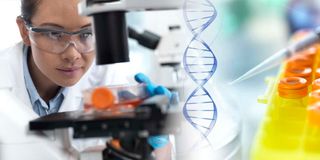Pioneering stem-cell trials in Japan report promising initial results

Laboratory researcher using a light microscope to examine stem cells in a culture jar.
First trials to test whether reprogrammed stem cells can repair diseased organs have begun to report positive results.
In an article by Nature, the researchers involved in the studies say they provide early hints that the highly anticipated technology works.
Ongoing trials are “delivering encouraging first insights into the evolution of iPS-cell-based therapies, from lab to patient,” says Wolfram-Hubertus Zimmermann, a pharmacologist at the University Medical Centre Göttingen in Germany.
However, researchers outside Japan are cautious about overstating the significance of the trials, saying they were small and the results are yet to be peer-reviewed.
Induced pluripotent stem (iPS) cells are a type of pluripotent stem cell derived from adult somatic cells that have been genetically reprogrammed to an embryonic stem (ES) cell-like state through the forced expression of genes and factors important for maintaining the defining properties of ES cells.
The biggest impact of the iPS-cell trials in Japan so far is that they “give people confidence all over the world that it is doable,” says Kapil Bharti, a translational stem-cell researcher at the US National Eye Institute in Bethesda, Maryland.
In January, researchers reported in a preprint that the first person in Japan given a transplant of heart-muscle cells made from reprogrammed stem cells had experienced improved heart function following the procedure.
Trial leader Yoshiki Sawa, a cardiac surgeon at Osaka University, now says all three Participants — aged in their fifties, sixties and seventies — have recovered and are back to work. He aims to recruit another five participants by the end of this year.
Cornea study
Another group of scientists in Japan announced in April that several people’s vision had improved after their diseased corneas were transplanted with corneal cells made from reprogrammed stem cells — a world first.
Ophthalmologist Kohji Nishida reported the first evidence that iPS-cell treatment had improved vision.
Three participants had markedly improved visions, a year after their operations — a fourth participant’s sight remained mostly the same because they had cataracts. He says the initial disease has not returned in any participant, some of whom had surgery more than two years ago, suggesting the cells survived the transplant.
Nishida is preparing a manuscript for publication and peer review, and he plans to start a larger trial with more than ten participants.
Also Read: The deadly search for a 'perfect' body
The cornea study was designed to treat people who have severe visual impairments because they lack the stem cells needed to repair the cornea.
Starting in 2019, Nishida used donor-derived iPS cells to create sheets of corneal cells implanted into one eye in each of the four participants.
Researchers outside Japan say the cornea trial is too small to establish the treatment’s effectiveness, but they are encouraged by the results.
In Japan, the observed beneficial effect of the cells has boosted scientists’ morale. “I’m very happy that the cornea could show that now,” says Jun Takahashi, a neurosurgeon at Kyoto University. The results are very important for regenerative medicine in Japan, she says.
Researchers still face other hurdles; chief among them are reducing the costs of producing the cells and getting industry support to take the technology beyond small studies and trials.
Suppose Jun Nishinda’s and Sawa’s trials demonstrate strong evidence of clinical efficacy without side effects. In that case, the treatments could become the first to get conditional approval to be sold in Japan as part of the government’s fast-track program for regenerative medicines.





